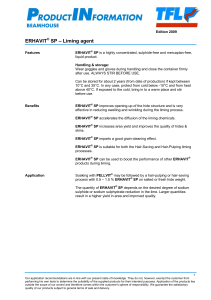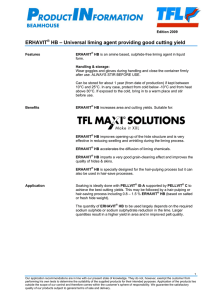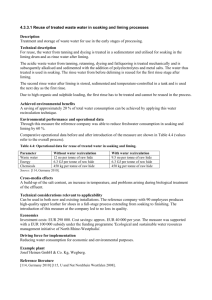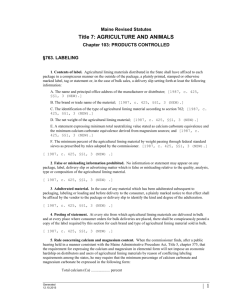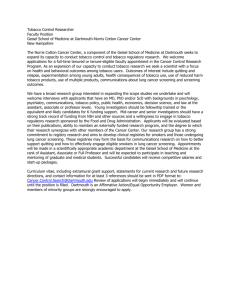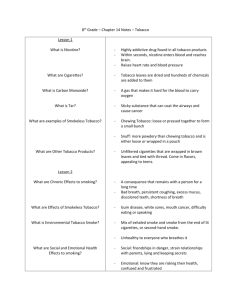Use waste of sugar factory in functions of yield increases and
advertisement
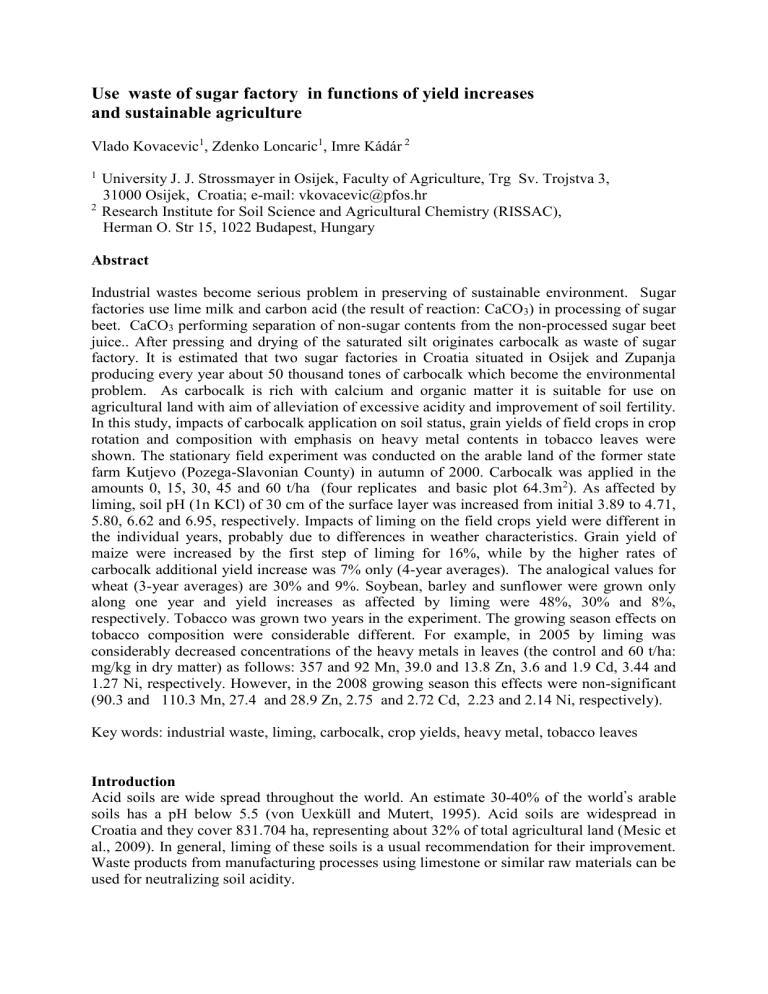
Use waste of sugar factory in functions of yield increases and sustainable agriculture Vlado Kovacevic1, Zdenko Loncaric1, Imre Kádár 2 1 2 University J. J. Strossmayer in Osijek, Faculty of Agriculture, Trg Sv. Trojstva 3, 31000 Osijek, Croatia; e-mail: vkovacevic@pfos.hr Research Institute for Soil Science and Agricultural Chemistry (RISSAC), Herman O. Str 15, 1022 Budapest, Hungary Abstract Industrial wastes become serious problem in preserving of sustainable environment. Sugar factories use lime milk and carbon acid (the result of reaction: CaCO3) in processing of sugar beet. CaCO3 performing separation of non-sugar contents from the non-processed sugar beet juice.. After pressing and drying of the saturated silt originates carbocalk as waste of sugar factory. It is estimated that two sugar factories in Croatia situated in Osijek and Zupanja producing every year about 50 thousand tones of carbocalk which become the environmental problem. As carbocalk is rich with calcium and organic matter it is suitable for use on agricultural land with aim of alleviation of excessive acidity and improvement of soil fertility. In this study, impacts of carbocalk application on soil status, grain yields of field crops in crop rotation and composition with emphasis on heavy metal contents in tobacco leaves were shown. The stationary field experiment was conducted on the arable land of the former state farm Kutjevo (Pozega-Slavonian County) in autumn of 2000. Carbocalk was applied in the amounts 0, 15, 30, 45 and 60 t/ha (four replicates and basic plot 64.3m 2). As affected by liming, soil pH (1n KCl) of 30 cm of the surface layer was increased from initial 3.89 to 4.71, 5.80, 6.62 and 6.95, respectively. Impacts of liming on the field crops yield were different in the individual years, probably due to differences in weather characteristics. Grain yield of maize were increased by the first step of liming for 16%, while by the higher rates of carbocalk additional yield increase was 7% only (4-year averages). The analogical values for wheat (3-year averages) are 30% and 9%. Soybean, barley and sunflower were grown only along one year and yield increases as affected by liming were 48%, 30% and 8%, respectively. Tobacco was grown two years in the experiment. The growing season effects on tobacco composition were considerable different. For example, in 2005 by liming was considerably decreased concentrations of the heavy metals in leaves (the control and 60 t/ha: mg/kg in dry matter) as follows: 357 and 92 Mn, 39.0 and 13.8 Zn, 3.6 and 1.9 Cd, 3.44 and 1.27 Ni, respectively. However, in the 2008 growing season this effects were non-significant (90.3 and 110.3 Mn, 27.4 and 28.9 Zn, 2.75 and 2.72 Cd, 2.23 and 2.14 Ni, respectively). Key words: industrial waste, liming, carbocalk, crop yields, heavy metal, tobacco leaves Introduction Acid soils are wide spread throughout the world. An estimate 30-40% of the world’s arable soils has a pH below 5.5 (von Uexküll and Mutert, 1995). Acid soils are widespread in Croatia and they cover 831.704 ha, representing about 32% of total agricultural land (Mesic et al., 2009). In general, liming of these soils is a usual recommendation for their improvement. Waste products from manufacturing processes using limestone or similar raw materials can be used for neutralizing soil acidity. Sugar factories use lime milk and carbon acid (the result of reaction: CaCO3) in processing of sugar beet. CaCO3 performing separation of non-sugar contents from the non-processed sugar beet juice.. After pressing and drying of the saturated silt originates carbocalk as waste of sugar factory. It is estimated that two sugar factories in Croatia situated in Osijek and Zupanja producing every year about 50 thousand tones of carbocalk which become the environmental problem. As carbocalk is rich with calcium and organic matter it is suitable for use on agricultural land with aim of alleviation of excessive acidity and improvement of soil fertility. The stationary field experiment of liming with carbocalk has been started in autumn of 2000. Mayority results originating from this experiment were published in the original ((Jurkovic et al., 2006; Kovacevic et al., 2006, 2010, 2012; Tursic et al., 2008; Rastija et al., 2012 ) and revial (Kovacevic and Loncaric, 2014) studies. Aim of this study was testing of liming effect on heavy metal concentrations in leaves of tobacco (Nicotiana tabacum) and short survey of yields of the field crops in used crop rotation. Material and methods The field experiment The field experiment with increased rates of carbocalk (waste of Osijek Sugar Factory, 39% CaO) was conducted in term November 8, 2000 on arable land of Kutjevo Agricultural Holding (Pozega-Slavonian County). Liming treatments were as follows (t/ha): 0, 15, 30, 45, and 60. The field trial was conducted in four replicates (experimental plot of fertilization 64.3m2). Crop rotation in the experiment since 2001 were shown in the Table 3. Sampling and chemical analysis Soil sampling for determination of influences liming on pH and humus contents was made in term July 24, 2004. Soil samples were taken from each plot by auger up to 30 cm of depth. Mean sample contained 15 individual samples. Uppermost fully developed leaves of tobacco were taken at mid-season (beginning of August) for chemical analysis. The total amounts of manganese (Mn), zinc (Zn), iron (Fe), copper (Cu), cadmium (Cd), nickel (Ni) and strontium (Sr) in tobacco leaves were determined using ICP after their microwave digestion by conc. HNO3+H2O2. Plant analyses were made by Jobin-Yvon Ultrace 238 ICP-OES spectrometer in the laboratory of the Research Institute for Soil Science and Agricultural Chemistry (RISSAC) of Hungarian Academy of Science and Arts in Budapest, Hungary. The data were statistically analyzed by ANOVA and treatment means were compared using t-test and LSD at 0.05 probability level. Weather characteristics Tobacco was grown on the experiment during the 2005 and the 2008 growing season. Considerable differences of precipitation quantities in July of 2005 and 2008 was found (Table 1). This difference could be used as explanation of specifity response of tobacco in 2005 and 2008 on tested element status as affected by liming (Tables 2 and 3). Table 1. Weather characteristics Year 2005 2008 LTM Slavonski Brod Weather Bureau (LTM: the long-term mean 1971-1990) Precipitation (mm) Mean air-temperature (oC) May June July Total May June July 48 100 175 323 16.8 19.3 21.6 70 88 85 243 17.5 21.4 21.5 74 82 87 243 15.9 18.8 20.6 Mean 19.2 20.1 18.4 Results and discussion Tobacco was grown two years in the experiment (Tables 2 and 3). The growing season effects on tobacco composition were considerable different. For example, in 2005 growing season (Table 3) by liming was considerably decreased concentrations of the heavy metals in leaves (the control and 60 t/ha: mg/kg in dry matter) as follows: 357 and 92 Mn, 39.0 and 13.8 Zn, 3.6 and 1.9 Cd, 3.44 and 1.27 Ni, respectively. However, in the 2008 growing season (Table 2) this effects were non-significant (90.3 and 110.3 Mn, 27.4 and 28.9 Zn, 2.75 and 2.72 Cd, 2.23 and 2.14 Ni, respectively). Cd in tobacco leaves is especially dangerous for human health (Ilyasova, 2005). Cd and the other toxic substances transforming in gaseous form during smoking under conditions of temperatures between 835 and 884 oC (Vorko, 1974). For this reason, tobacco smoking is dangerous both for smokers and people in their environment. Table 1. Residual influences of liming with carbocalk (39 % CaO) in 2000 on the heavy metal contents in tobacco leaves growing in season 2008 Element Liming (autumn 2000) with carbocalk (t/ha) 0 15 30 45 60 Mean LSD 5% Tobacco leaves (mg/kg on dry matter basis) - the growing season 2008 Manganese (Mn) Zinc (Zn) Iron (Fe) Copper (Cu) Cadmium (Cd) Chromium (Cr) Nickel (Ni) Strontium (Sr) 90.3 27.4 144 16.4 2.75 0.19 2.23 29.1 75.3 14.0 138 13.6 1.78 0.18 1.28 28.4 76.6 16.1 135 13.1 1.97 0.21 1.62 26.5 106.0 28.0 169 14.2 2.76 0.25 1.87 30.1 110.7 28.9 118 16.0 2.72 0.21 2.14 28.8 91.8 22.9 141 14.7 2.40 0.21 1.82 28.6 ns 6.1 ns 3.1 0.59 ns 0.39 ns Table 3. Residual influences of liming with carbocalk (39 % CaO) in 2000 on the heavy metal contents in tobacco leaves growing in season 2005 (Tursic et al., 2008) Element Liming (autumn 2000) with carbocalk (t/ha) 0 15 30 45 60 Mean LSD 5% Tobacco leaves (mg/kg on dry matter basis) - the growing season 2005 Manganese (Mn) Zinc (Zn) Iron (Fe) Copper (Cu) Cadmium (Cd) Chromium (Cr) Nickel (Ni) Strontium (Sr) 357 39.0 104 14.7 3.6 0.22 3.44 29.0 87 40.6 114 17.6 2.2 0.26 1.33 22.6 85 33.6 126 17.3 2.1 0.30 1.18 23.0 79 15.1 151 16.4 1.9 0.26 0.95 24.6 92 13.8 192 17.1 1.9 0.31 1.27 25.7 140 28.4 137 16.6 2.3 0.27 1.63 19.6 25.0 3.1 23.0 ns 0.4 0.07 0.31 4.7 Table 3: Grain yields of the field crops in the experiment in the period from 2001 to 2012 (Kovacevic and Loncaric, 2014) The field crop Year Maize Maize Sunflower Barley Tobacco Maize Wheat Tobacco Wheat Maize Soybean Wheat 2001 2002 2003 2004 2005 2006 2007 2008 2009 2010 2011 2012 pH H2O pH 1nKCl Carbocalk (t/ ha) 0 15 30 45 60 Grain yield t/ ha) 5.04 6.19 6.39 6.72 7.56 5.51 6.66 6.77 6.82 7.50 2.72 3.77 4.04 3.46 3.31 5.79 7.50 7.29 6.82 7.05 Leaf composition was tested (Tursic et al., 2008) 7.28 7.68 7.88 8.26 8.06 5.04 6.77 7.03 7.25 6.66 Leaf composition was tested 5.04 6.96 7.09 7.14 7.07 8.40 9.94 9.69 9.73 9.58 2.13 2.09 2.09 2.19 2.30 5.49 6.46 6.80 6.58 7.30 Soil pH (July 24, 2004) 5.33 5.81 6.52 7.12 7.35 3.89 4.71 5.80 6.62 6.95 LSD 5% 1.05 0.92 0.41 0.76 0.56 0.34 0.66 0.89 0.11 0.45 0.25 0.32 As affected by liming, soil pH (1n KCl) of 30 cm of the surface layer was increased from initial 3.89 to 4.71, 5.80, 6.62 and 6.95, respectively. Impacts of liming on the field crops yield were different in the individual years, probably due to differences in weather characteristics. Grain yield of maize were increased by the first step of liming for 16%, while by the higher rates of carbocalk additional yield increase was 7% only (4-year averages). The analogical values for wheat (3-year averages) are 30% and 9%. Soybean, barley and sunflower were grown only along one year and yield increases as affected by liming were 48%, 30% and 8%, respectively (Table 3). Conclusion Carbocalk has been indicated as useful for improvement of acid soils and yields of field crops. Impact of liming on the heavy metal concentrations in tobacco leaves was specific in two tested growing seasons: mainly without significant effects in 2008 and considerably decreases of heavy metal concentrations in 2005. Application of the lowest rate of carbocalk in amount 15 t ha-1 is adequate for practical using in soil management for increases of yields of main field crops. References Ilyasova D. (2005): Cadmium and renal cancer. Toxicol. Appl .Pharmacol. 207(2):179-186. Jurkovic Z., Josipovic M., Drezner G., Jurkovic V., Banaj D. (2008): Residual effects of liming with carbocalk on maize and wheat status. Cereal Research Communications 36 (Suppl.): 767-770. Kovacevic V., Banaj D., Kovacevic J., Lalic A., Jurkovic Z., Krizmanic M. (2006.): Influences of liming on maize, sunflower and barley. Cereal Research Communications 34 (1): 553-556. Kovacevic V., Kádár I., Drezner G., Banaj D., Rékási M. (2010): Residual impacts of liming on wheat yield In: Proceedings of 45th Croatian and 5th International Symposium of Agriculuture, Opatija 15-19 February 2010 (Maric S. and Loncaric Z. Editors), Faculty of Agriculture in Osijek, p. 801-803. Kovacevic V., Loncaric Z. (2014): Using of carbocalk for improvement of soil fertility. Technologica Acta, Tuzla, Bosnia and Herzegovina (in press). Kovacevic V., Rastija D., Sudar R., Iljkic D. (2012): Ucinak kalcizacije karbokalkom na tlo, prinos i kvalitetu zrna kukuruza. Glasnik zaštite bilja 56 (6): 54-60. Mesić M.: (2001): Korekcija suvišne kiselosti tla različitim vapnenim materijalima, Agriculturae Conspectus Scientificus, 66 (2): 75-93. Rastija M., Sudaric A., Kovacevic V., Iljkic D., Varga I. (2012): Impacts of liming on yield, protein contents and cadmium status o soybean. In: Safe Food, Proceedings of 16th International Eco-Conference (Aleksic N., Editor), 26 - 29 Sept. 2012, Novi Sad, Serbia, Ecological Movement of Novi Sad, p. 243-250. Tursic I., Kovacevic V., Banaj D., Husnjak S.,Zalac S. (2008): Influences of liming on the heavy metal contents in tobacco leaves. Proc. 17th Intern. Symp. Of CIEC, 24-27 Nov. 2008, NRC (Micronutrient Project), Cairo Egypt, 53-57. von Uexküll H. R., Mutert E. (1995): Global extent, development and economic impact of acid soils. Plant and Soil 171: 1-15.
